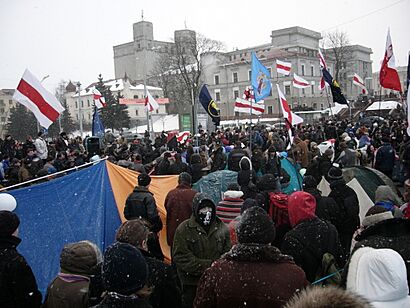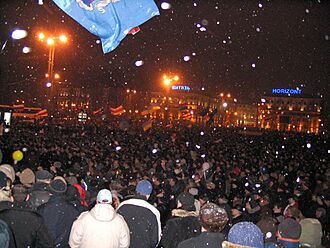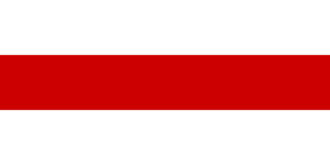Jeans Revolution facts for kids
Quick facts for kids 2006 Belarusian protests |
|
|---|---|

Opposition demonstration following the presidential election on October Square, Minsk, 21 March 2006
|
|
| Date | 19–25 March 2006 |
| Location |
Belarus
|
| Caused by |
|
| Goals |
|
| Methods | Demonstrations |
| Resulted in |
|
The Jeans Revolution (Belarusian: Джынсавая рэвалюцыя, transliteration: Džynsavaja revalucyja, Russian: Джинсовая революция, romanized: Dzhinsovaya revolyutsiya) was a name given to protests in Belarus. These protests happened after the 2006 Belarusian presidential election. People who were against the government used this name.
Why Was It Called the Jeans Revolution?
The Jeans Revolution was also known as the Cornflower Revolution or the Denim Revolution. These names came from the color blue. It was meant to be like other "color revolutions" around the world. However, unlike some of those, the Jeans Revolution did not lead to big changes in Belarus.
The name "Jeans Revolution" started on 16 September 2005. This was during a public protest against the government's leader, Alexander Lukashenko. On that day, police took away the white-red-white flags used by the protesters. These flags were not allowed by the government.
Then, a young activist named Mikita Sasim from the youth group Zubr held up his denim shirt. He said this shirt would be their new flag. In countries that used to be part of the Soviet Union, jeans often stood for Western culture.
The people protesting in Belarus saw denim as a symbol. It showed they were against Lukashenko's "Soviet-like" rules. It also sent a message that Belarusians were "not cut off from the West". After this, the Zubr group suggested wearing jeans on the 16th day of every month. This was to remember people who had disappeared in Belarus.
Protests After the 2006 Election
The name "Jeans Revolution" became very well known after protests in Minsk. Minsk is the capital city of Belarus. These protests happened because people disagreed with the results of the 2006 elections.
The protests started right after the voting ended on Sunday, March 19. More than 10,000 people gathered in a main square. Each night, fewer people came. About 5,000 came on Monday, and 3,000 to 4,000 on Tuesday. By March 23, only about 200 young protesters remained. They stayed around a tent camp set up by the opposition in October Square.
On March 24, the government sent in riot police. They cleared out the tent camp in October Square. The police told the protesters to leave. State television reported that no one was hurt during this action. Some people watching thought the police were quite gentle. They believed the Belarusian president might have wanted to seem more reasonable to other countries.
President Alexander Lukashenko had said that protests like the Orange, Rose, and Tulip Revolutions would not happen in Belarus. He stated that "force will not be [allowed to be] used" to take over the presidency. Belarusian officials promised to stop any large protests after the election.
On March 20, Alaksandar Milinkievič spoke to about 7,000 supporters. He told them their protests would be a long effort. He said, "We, free people of Belarus, will never recognise the election. They are afraid of us. Their power is based on lies."
However, Lukashenko again claimed his rivals had planned pro-Western revolts. He compared them to those in Ukraine and Georgia. He said during a press conference, "Let me say that the revolution that so many people talked about and some were preparing, has failed."
On March 25, about 45,000 protesters faced police forces. The police waited for riot squads to arrive. Later, there were clashes between the protesters and the riot police. The protesters were eventually pushed back. More than 100 people were arrested. This included Alexander Kozulin, who supported the protests and ran against Lukashenko. Police reportedly hurt Kozulin during his arrest. In July 2006, Kozulin was put in prison for his actions during the protests.
Also on March 25, Milinkievič said he hoped for a month-long break in protests. He seemed to hope he could build up more support and calm people down.
The Belarusian filmmaker Yury Khashchavatski made a movie about the opposition movement. It showed the protests after the election. The film was called Kalinoŭski Square.
Another movie, A Lesson of Belarusian, was directed by Miroslaw Dembinski. It showed the events leading up to the "Jeans Revolution." The government said this movie had "extreme material" and was "forbidden to watch in the country."
See also
- Belarus Free Theatre
- "A Day of Solidarity with Belarus"
- Under the Radar Festival
- A Lesson of Belarusian



